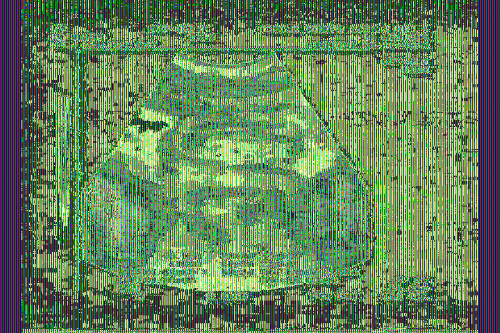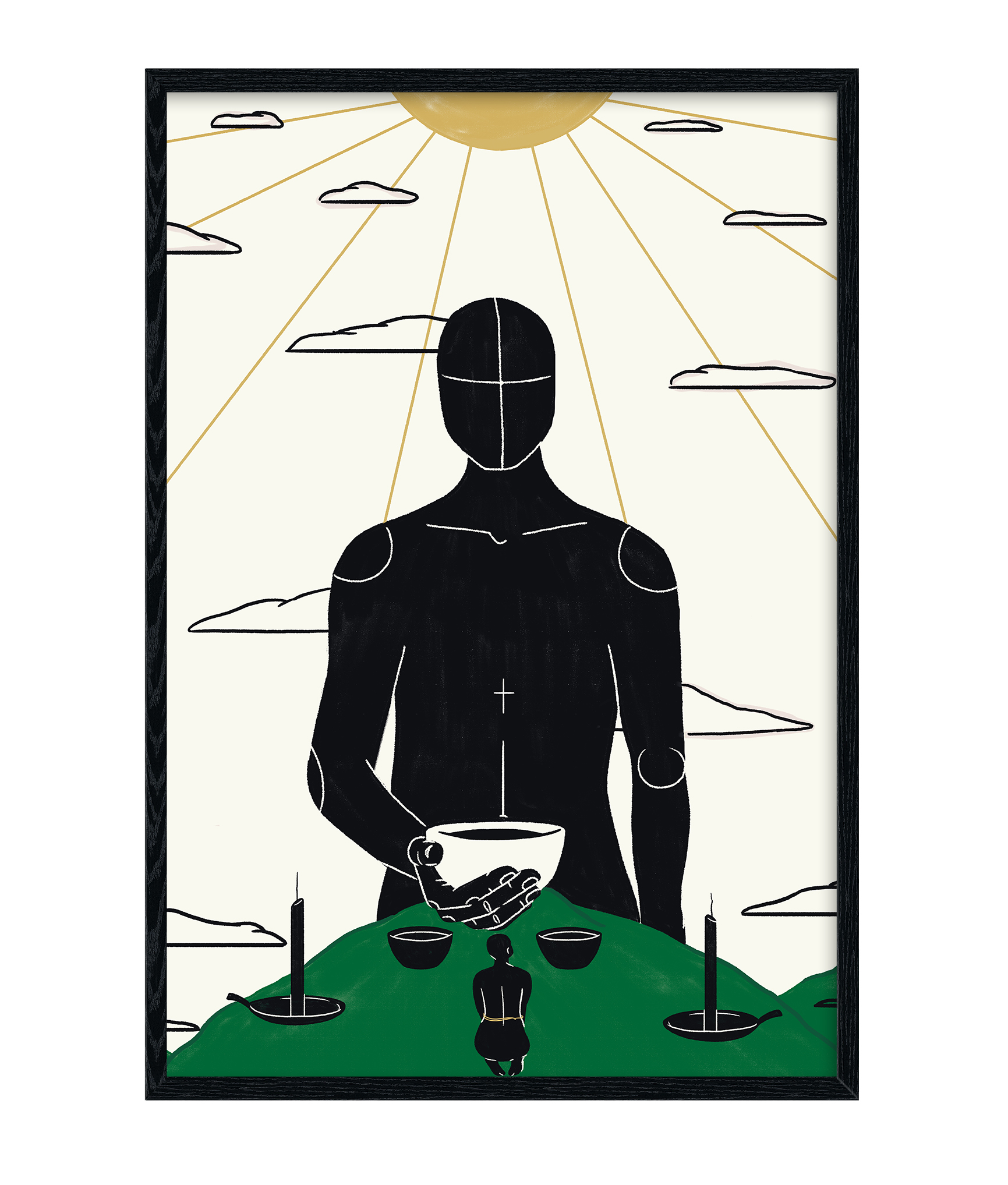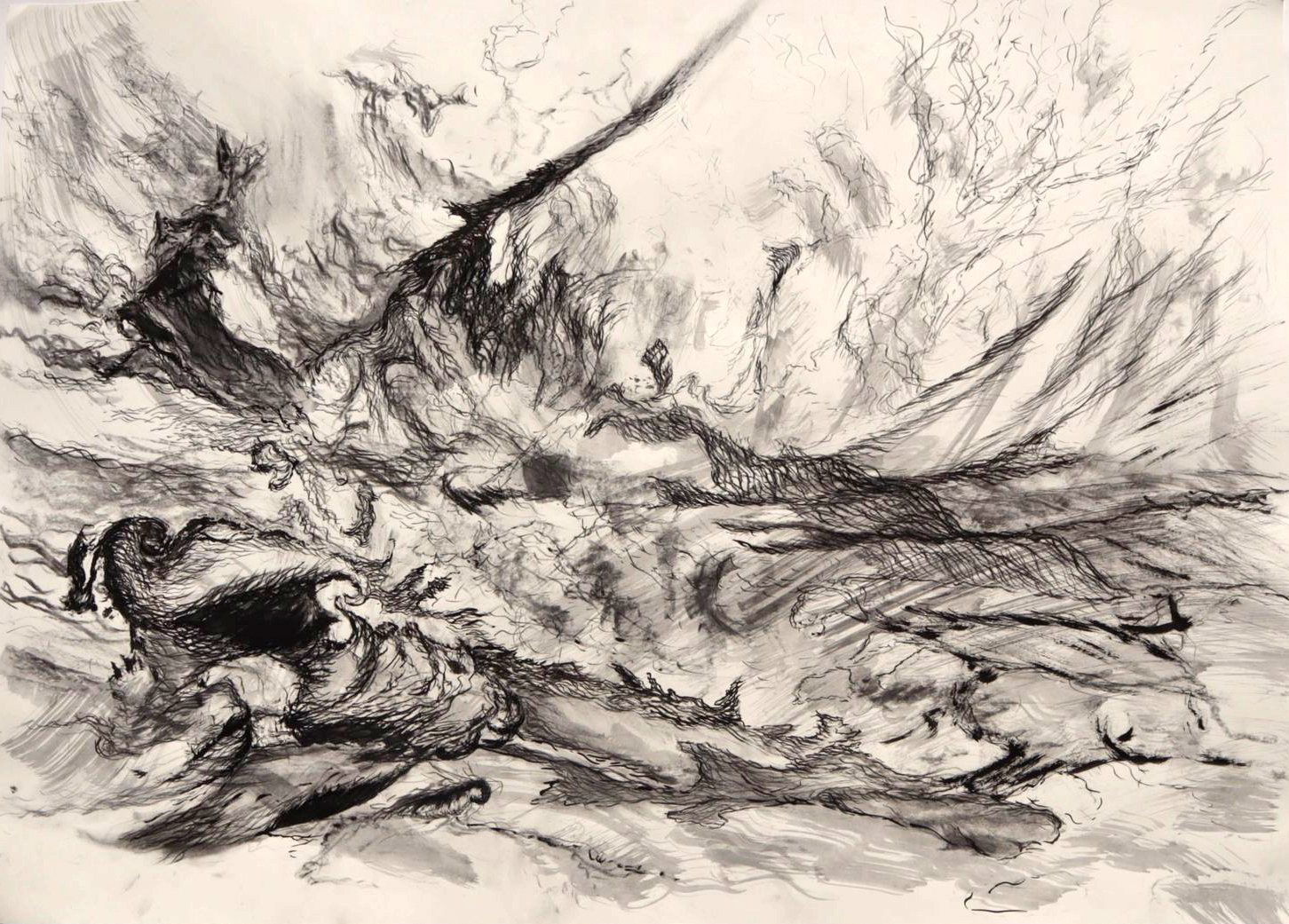The following journeys present windows into the soul of the world as we experience, perceive, as we are, as we en(in)vision. In comparison to the growth of the tarot in its re-emergence in social media, popular culture and fashion as a site for inspiration and embedded stereotypes around the idea of the tarot, these artists seek to look within and among each other — so as to add flavour to the currents by highlighting transformative art-making processes that inform their lives and works.
States Jordan Cassidy Anthony about her recent curatorial project en(in)vision. Jordan Anthony is a Durban based artist and curator who recently completed her Bachelor of Art in Fine Art at the University of the Witwatersrand, Johannesburg. In her own artistic practice, Jordan is influenced by her immediate physical and spiritual environment and draws from her interest in disciplines such as anthropology, archaeology, astronomy, visual cultures and the esoteric. However, with en(in)vision Jordan was influenced and informed by the idea of ‘the fool’s journey’ as located within the narrative of the tarot.
This resulted in the coming together of works by emerging artists, including Bubblegum Residency recipient Tzung-Hui Lauren Lee. After having applied for a previous position at Latitudes, Jordan was contacted by the Latitudes team through email earlier this year about their CuratorLab programme, a practice-based, online curatorial residence for young curators in South Africa. Realising this as a great opportunity to present ideas that Jordan had been thinking through but was only beginning to comprehend theoretically — and much more so based on personal experience — she made the most of the CuratorLab programme.

Tristan Baia, ULTRASOUND : STILL 004, 2021
With the support of the Latitudes team, offering insight into how to navigate the business side of curatorship as well as conceptual support, Jordan made the most of this curatorial opportunity by bringing new perspectives to the online exhibition space. As a young curator, her eye for putting together a body of work that well represents her curatorial prompt is well beyond its years. “I have always been drawn to the possibilities of what different disciplines can bring to the art space and how, as an artist, an intuitive being, a researcher — one can begin to play and experiment with knowledge,” she explains. As a young creative with an interest in curation, I reached out to Jordan to learn more about her curatorial ventures. Through conversing with her about en(in)vision it became apparent the level of skill and professionalism she exudes.
You can find a viewing room showcasing works from en(in)vision here, with selected artworks still available for purchase.

Sisanda Nxumalo, IIade, 2021
I would like to know more about the process of curating an online exhibition.
Jordan Anthony: The process, I would say, worked similar to that of a regular physical exhibition in terms of project conceptualisation up until having the works come together in one space (that being on google drive). This google drive space was, in fact, my first space for curation. This is kind of where my mind sat when ‘figuring out’ how this content would sit online, and what it would look like. If I might add as well, I also created a catalogue that served as the second curatorial space; [here] I curated the content as if practising for the actual online space.
Thereafter, I realised the emphasis was not so much on how I upload works to the site since its upload phase would simply make the works available. Instead, I treated the catalogue as the exhibition and designed the layout such that it not only held the visual impact I was looking for, but also held the conceptual narrative I was showcasing. Since I had the artists respond to a curatorial brief, the show became solely dependent on the outcome of the artist’s response to that brief and I am proud to say the result was entirely as I had hoped it would be — that each artist brought out an essence of which I could never have ‘conceptualised’ on my own.
What was the underlying concept for your exhibition/show?
Jordan Anthony:I can say what it is not — one specific narrative. But it is largely outlined by the narrative of the fool’s journey as within the historical narrative of the Tarot. Not so simple, yet very much in its narration of life. The fool’s journey (within Western/European notions) represents the journey of life and the various trials and tribulations that one encounters on their path. It is said to be the path to enlightenment and the realisation of Anima Mundi, the very soul of the world.The journey I wished to present was that of one formed out of personalised narratives of the South. The formulation of this idea was not to push the bandwagon idea of a trendy form of spiritual enlightenment that many seem to hold onto in terms of its stereotyped/ preconceived notions being that of fortune-telling/mysticism, or the occult.
Although the Tarot has been used in such instances to drive personal agendas/beliefs and stereotypes, I wished to focus on bringing some ground for looking at this narrative within Tarot from the perspective of those who are healing; those who are in their process of realising [the] self; and those who have encountered some of the traditional elements of the major arcana in tarot (The Sun, The Lovers, Death, Strength, The World). The difference in this narrative being [a] representation of such arcana. I did not envision crystal ball content, but works that bring out the real arcana of each artist and their current point in their personal journeys. This was the preliminary concept that I presented as a brief for the artists. It was for them to present a piece of their reality.

Raphaela Cocotos, Repetition II, 2021
How was it working with emerging artists, was it important for you to showcase their work especially?
Jordan Anthony: It was a great experience to work with this group because not only were some already beginning their journey of launching themselves out there, but it was also a first for some of the artists who have never had their work on a platform like Latitudes. These artists have all dared to share important parts of themselves with me, and it was simply so refreshing to consult with each one of them and get a better understanding of the artist’s process and how their thinking translates into practice.
It was not so much the importance of who I showcased, rather it was the work and the processes that each artist used in practice. Each process was unique (as with all artists) but they all had something more than aesthetic or mass-produced/trendy. They carried weight and power that did not aim to serve what the public wanted to see/buy or what the aesthetic perception of tarot was. They simply followed their own journey and collectively produced a beautiful encounter of the Soul of the world.
If you could give any advice to young curators, what would you say?
Jordan Anthony: Trust your intuition, it will never fail you (unless you self-sabotage regularly, then turn to a trusted source). Proactively search for information and broaden your perspective, having a birds-eye view helps. Organising is key and so is studying your environment/audience/focus. Collaborate with other young curators (network) who are in alignment with your vision/aim.

Tzung Hui Lauren Lee, 18 March // 18月的云, 2021
How has your own artistic practice influenced the way you curate?
Jordan Anthony: I guess just from [the] process alone and the experience of making a work, conceptualising and stepping back — all in varied order — has inherently allowed me the ability to understand where an artist is coming from and the concerns that an artist may have when collaborating with a curator on a show.
This was a big learning experience for me since I have never curated on the online space before and I was unsure of what was right and wrong but I did hold integrity to what I envisioned.
Is there anything from a curatorial point of view that you feel really stood out as important to you when putting the exhibition together?
Jordan Anthony: Well, the show was dependent on the works and the artist’s response so I would say that there was a point at which I had to ‘screen’ works or select ones that would be included — as well as work with Latitudes on which works I would include. It really helped consulting with the artists on what they felt was strong and then contrasting that to what the Latitudes representatives said and finding a balance with the works I felt had to be shown.
I think overall, it would be finding balance in knowing how much advice to take and being selective about what kind of advice you want to pursue. Sometimes you may not trust yourself but it is really vital to believe in your initial feeling towards something which usually (in my experience) ends up being the anchor of an experience.
Describe your experience with researching pieces and finding artists that you felt best suited your curatorial question.
Jordan Anthony:This was quite natural to me as I always preferred to dig a little deeper on whatever it was that I had an interest in. I held consultations with the artists and we discussed the process and thinking towards the realisation of the final works, which I was very happy about. Some works were already in existence, however, I still felt that they would be integral towards the exhibition and its intended effect. I had begun my research into the tarot a few months prior to Latitudes contacting me, and when the opportunity arrived, I decided to go with it.
It wasn’t a great search since I knew of artists that produced work that I personally thought were crucial to this time. I approached artists [with] whom I had had previous encounters, be it from making art together in a studio or those who I knew from past connections; people I met by chance, and people I met online. Because the curatorial brief was suited towards those leaving a significant impact, I chose these artists based on their work and the personal power each had in leaving a potentially greater impact.

Kelly Van Graan, Conversations Only We Had III (Triptych), 2021
What is the greatest challenge of curating projects in non-conventional, non-gallery spaces?
Jordan Anthony: I think that would be the physical connection aspect of engaging with a work versus in the digital space. Some works are just built for the digital, whereas some are better appreciated in person.
I think that transition and how one puts together a show with varied mediums on a digital space, is something that I’m still wrapping my head around but I have already done myself. On the other hand, each challenge and space is unique, so follow the works first, I say the works will lead you to a solution. You just have to see, not look.
In your opinion — as a young curator — how would you suggest an artist contact or approach a curator? Should they even approach them?
Jordan Anthony:I don’t think there should be that big of a boundary between artist and curator, unless it’s detrimental to either and goes against an agreement. I also feel like artists should feel free to engage with curators and approach them if they feel comfortable. This could be simply to start a conversation about a process or any opportunities for the artist to show works.
At present, I’d shy away from physically approaching people but an email always works and perhaps you may schedule a meeting and have a conversation or meet up safely. On the other hand, this is a good question because how many contactable curators are there? I’m available on weekends?
To you, is it important for curators to be brave and lead in new modes of thinking?
Jordan Anthony:100%, however, there’s always the consideration that one has to have when curating a narrative or pushing an agenda/making a statement through other artist’s work.
In driving new methodologies of thinking about works and how they work together, you have to be confident that what you are putting out there adds and doesn’t take away from the work you choose to include or completely annihilate its past narratives (unless for change/creation of ‘adapted/new’ narratives). With this said, I think that bravery, especially when navigating complex narratives, is a great trait for the right cause, with [a] healthy awareness of course. There are many factors.
 Matty Monethi, Swimming Pool, 2021
Matty Monethi, Swimming Pool, 2021



















































